
| Version | Summary | Created by | Modification | Content Size | Created at | Operation |
|---|---|---|---|---|---|---|
| 1 | Kedar Mehta | + 4331 word(s) | 4331 | 2021-05-28 04:21:18 | | | |
| 2 | Peter Tang | Meta information modification | 4331 | 2021-07-29 04:22:21 | | |
Video Upload Options
Despite plentiful domestically available energy resources, the energy supply in Central Asia is very unevenly distributed between urban and rural areas. Almost half of the total population of Central Asia lives in rural areas and there is a lack of access to modern energy services to meet primary needs.
1. Introduction
1.1. Background and Context
|
Indicator |
Kazakhstan |
Turkmenistan |
Uzbekistan |
Kyrgyzstan |
Tajikistan |
|---|---|---|---|---|---|
|
Surface area in km2 |
2,724,902 |
488,100 |
447,400 |
199,950 |
141,380 |
|
Population in million |
18.2 |
5.8 |
32.95 |
6.3 |
9.1 |
|
Share of rural population in % |
43 |
43 |
50 |
64 |
73 |
|
Gross Domestic Product in billion |
USD 170 |
USD 40.761 |
USD 50.49 |
USD 8.0 |
USD 7.5 |
|
Gross National Income/capita |
USD 7970 |
USD 6380 |
USD 2000 |
USD 1130 |
USD 990 |
1.2. A Framework of Energy Resources
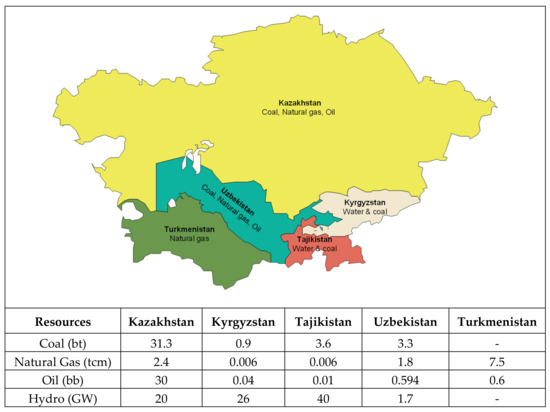
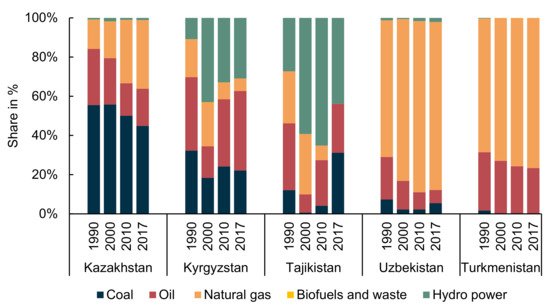
1.3. Objective and Methodology
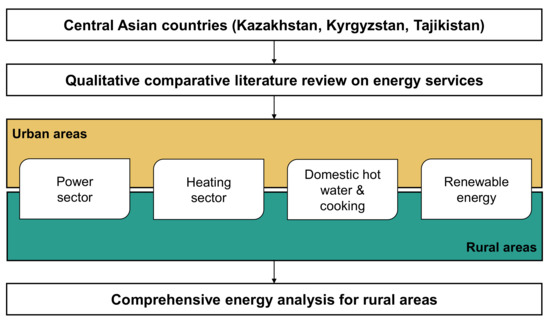
2. The Central Asian Power Sector
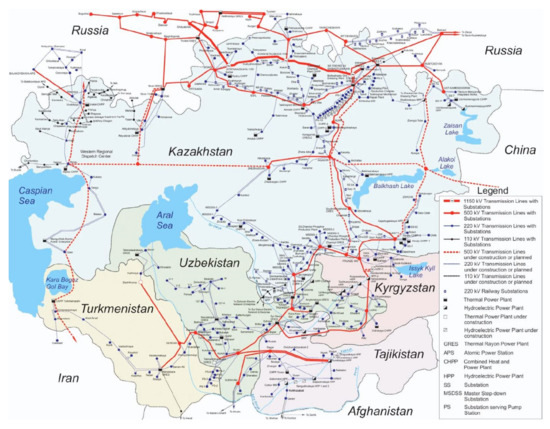
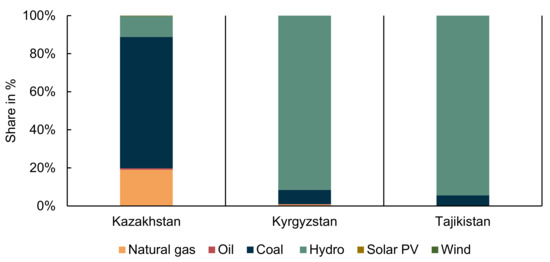
3. The Central Asian Heating Sector
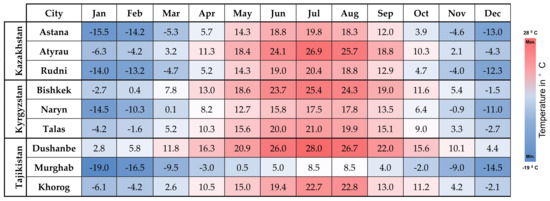

4. Hot Water Preparation and Cooking in Central Asia
4.1. Domestic Hot Water
|
Area |
Kazakhstan |
Kyrgyzstan |
Tajikistan |
|---|---|---|---|
|
Urban area |
78 |
85 |
93 |
|
Rural area |
>35 |
58 |
49 |
4.2. Cooking Methods and Fuel Sources for Cooking
5. The Potential of Renewable Energy in Central Asia and Current Trend
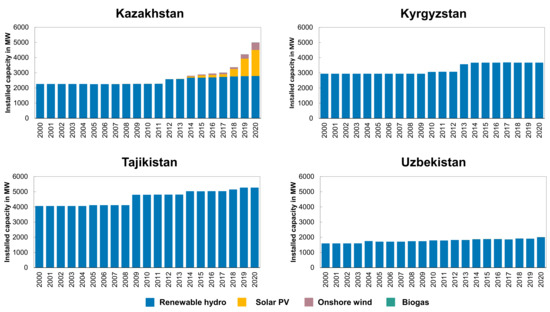
|
Author |
Research Title |
Research Aim |
Key Findings |
|
|---|---|---|---|---|
|
Central Asia |
Shardina (2020) [65] |
Non-Hydropower Renewable Energy in Central Asia: Assessment of Deployment Status and Analysis of Underlying Factors |
This paper aimed to assess the reasons behind the untapped and limited development of RE sectors in Central Asian countries. |
The article summarises that RE sources are distributed unevenly, and the author also suggested policy implications to improve the commitment to RE in Central Asia. |
|
Nurdavletova and Akatayeva (2018) [69] |
The renewable energy in the regional development of Central Asia |
The main objective of the article was to investigate the available alternative sources in Central Asia and inter-regional complexity. |
The article provided a glance at the potential of the RE sector in individual countries and key hurdles in detail for the implementation of RE in Central Asian republics. |
|
|
Abylkasymova (2019) [76] |
Wind Power Potential of the Central Asian Countries |
Theoretical wind power supply capacity as well as existing wind power installations were investigated as a key aim of the article. |
Wind power has significant theoretical potential in all Central Asia countries. Over 70% of regional total wind potential is concentrated in Kazakhstan. |
|
|
Gubaidullina et al. (2017) [77] |
Renewable energy and the regional prospect on sustainable development of Central Asia |
The paper aimed to provide useful information on the issues of renewable energy in Central Asia, as well as the insight of RE status for individual countries. |
The most rapid development in the field of renewable energy is noticed in Kazakhstan and the least developed sphere of RES is in Turkmenistan. |
|
|
Kiseleva et al. (2017) [78] |
Efficiency estimation for the grid-tie photovoltaic stations construction in some regions of Central Asia and Transcaucasia |
This techno-economic assessment evaluated the construction of network PV farm (5 MW) in selected regions of Central Asian countries. |
By consideration of local feed-in tariffs, the simple payback period was determined to last 4–6 years in different regions of Central Asia for small scale PV farms (5 MW). |
|
|
Kazakhstan |
Zavadskiy and Revalde (2020) [79] |
Problems of development of renewable energy facilities in rural regions on the example of Kazakhstan |
This manuscript presents an outline of the difficulties and problems with the development of renewable energy sources in the rural regions of Kazakhstan |
Kazakhstan possesses great renewable energy potential, especially in rural areas (solar, wind and bioenergy). The research article also recommends employing a special programme/policy to promote RE in Kazakhstan. |
|
Vakhguelt (2017) [80] |
Renewable Energy Potential of Kazakhstan |
The article presents the recent status quo of available potential of hydropower, wind power, solar power, geothermal energy, and bioenergy and their available operations in Kazakhstan. |
Kazakhstan has a great potential for renewable energy production. Most of the Kazakh territory has great solar potential as well as considerable wind energy. |
|
|
Karatayev et al. (2016) [81] |
Renewable energy technology uptake in Kazakhstan: Policy drivers and barriers in a transitional economy |
With the help of the analytical hierarchy process, this paper investigates and ranks the different barriers towards the adoption of renewable energy in Kazakhstan. Also, it provides interesting insights into the country’s legal framework. |
It was identified that sustainable and affordable RE systems toned to be introduced in Kazakhstan for low carbon energy generation. Despite abundant available RE resources renewable energy currently contributes to less than 1% of the country’s power generation. |
|
|
Kyrgyzstan |
Abidov et al. (2020) [82] |
Comparative Analysis of Some Types of Renewable Energy Sources |
The article discussed the current state and possibilities of using alternative energy in Kyrgyzstan. It also assessed non-traditional renewable energy sources as well as the economic efficiency and its payback period. |
The article identified that each type of RE source has its positive benefits in various regions of Kyrgyzstan. It also explained the reasons behind the insufficient use of RE in Kyrgyzstan. |
|
Baybagyshov and Degembaeva (2019) [72] |
Analysis of the usage of renewable energy in Kyrgyzstan |
The manuscript defined the analysis results of the opportunity of using renewable energies (Solar, wind, hydro, biomass, and geothermal) in Kyrgyzstan. |
The analysis showed that the country has a great potential for renewable energy, which is unexploited. The use of renewable energy for Kyrgyzstan should be considered as a solution to population’s socio-economic problems in the decentralised high-altitude regions region. |
|
|
Tajikistan |
Schulz et al. (2014) [83] |
The energy supply for mountain settlements in Tajikistan based on renewable energy sources |
This article investigated the electrification of mountain settlements/communities of Tajikistan by means of combined forms of renewable energy sources (i.e., a small hybrid hydropower station, small PV station). |
The article claimed that there is an immediate need to solve the seasonal deficiency of the Tajik power sector. It suggests that a small-scale hybrid power station operated by combined RE sources will be suitable for sustainable electricity supply for remote settlements in Tajikistan. |
|
Doukas et al. (2012) [84] |
Promoting renewables in the energy sector of Tajikistan |
The document presented multi-dimensional approach to identify the suitability of decentralised heat production in Tajikistan. |
Technically, a low-pressure solar water heater is a more suitable design for Tajikistan. Also, the paper identified the hurdles for further development of decentralised heat production. |
References
- Rao, P.S.C.; Miller, J.B.; Wang, Y.D.; Byrne, J.B. Energy-microfinance intervention for below poverty line households in India. Energy Policy 2009, 37, 1694–1712.
- Brew-Hammond, A. Energy access in Africa: Challenges ahead. Energy Policy 2010, 38, 2291–2301.
- Angelou, N.; Bhatia, M. Capturing the Multi-Dimensionality of Energy Access (English): Live Wire Knowledge Note Series, Washington. 2014. Available online: (accessed on 5 April 2020).
- Carrillo, N. Assessment of Household Energy Access: The Progress out of Energy Poverty Index (PEPI) Toolkit for the Microfinance Sector. Ph.D. Thesis, Technical University of Berlin, Berlin, Germany, 2017.
- Muhumuza, R.; Zacharopoulos, A.; Mondol, J.D.; Smyth, M.; Pugsley, A. Energy consumption levels and technical approaches for supporting development of alternative energy technologies for rural sectors of developing countries. Renew. Sustain. Energy Rev. 2018, 97, 90–102.
- Monyei, C.G.; Akpeji, K.O. Repurposing Electricity Access Research for the Global South: A Tale of Many Disconnects. Joule 2020, 4, 278–281.
- Hostettler, S.; Gadgil, A.; Hazboun, E. Sustainable Access to Energy in the Global South; Springer International Publishing: Cham, Switzerland, 2015; ISBN 978-3-319-20208-2.
- Mainali, B.; Silveira, S. Alternative pathways for providing access to electricity in developing countries. Renew. Energy 2013, 57, 299–310.
- Shadrina, E. Renewable Energy in Central Asian Economies: Role in Reducing Regional Energy Insecurity; ADBI Working Paper 993, Tokyo. 2019. Available online: (accessed on 5 April 2020).
- World Bank. Central Asia—Water and Energy Program: Working for Energy and Water Security (English) No. 141508, Washington. 2019. Available online: (accessed on 24 October 2020).
- World Bank. Surface Area (sq. km). Available online: (accessed on 24 October 2020).
- World Bank. Population. Available online: (accessed on 20 February 2019).
- World Bank. GDP (current US$). Available online: (accessed on 30 October 2020).
- World Bank. GNI per Capita, Atlas Method (Current US$). Available online: (accessed on 30 October 2020).
- Pohl, B.; Kramer, A.; Hull, W.; Blumstein, S.; Abdullaev, I.; Tais, K.J.R.; Strikeleva, E.; Interwies, E.; Görlitz, S. Rethinking Water in Central Asia: The costs of Inaction and Benefits of Water Cooperation; Swiss Agency of Development and Cooperation (SDC): Berlin, Germany, 2017.
- Batsaikhan, U.; Dabrowski, M. Central Asia—twenty-five years after the breakup of the USSR. Russ. J. Econ. 2017, 3, 296–320.
- Dowling, M.; Wignaraja, G. Central Asia after Fifteen Years of Transition: Growth, Regional Cooperation, and Policy Choices, Philippines. 2006. Available online: (accessed on 5 April 2020).
- Batsaikhan, U.; Dabrowski, M. Central Asia at 25. Available online: (accessed on 24 February 2020).
- Raballand, G.; Kunth, A.; Auty, R. Central Asia’s transport cost burden and its impact on trade. Econ. Syst. 2005, 29, 6–31.
- Linn, J.F.; Blaxall, M. Central Asia Human Development Report 2005: Bringing Down Barriers: Regional Cooperation for Human Development and Human Security; UNDP Regional Bureau for Europe and the Commonwealth of Independent States: Bratislava, Slovakia, 2005; ISBN 92-95042-34-4.
- Russell, M. Connectivity in Central Asia: Reconnecting the Silk Road. Available online: (accessed on 5 April 2020).
- Bobojonov, I.; Aw-Hassan, A. Impacts of climate change on farm income security in Central Asia: An integrated modeling approach. Agric. Ecosyst. Environ. 2014, 188, 245–255.
- Hamidov, A.; Helming, K.; Balla, D. Impact of agricultural land use in Central Asia: A review. Agron. Sustain. Dev. 2016, 36, 77.
- USAID. Climate risk profile: Central Asia: Fact Sheet. Available online: (accessed on 30 October 2020).
- Asian Development Bank. Central Asia Atlas of Natural Resources; Asian Development Bank: Metro Manila, Philippines, 2014; ISBN 978-971-561-886-1.
- Orlovsky, L.; Orlovsky, N.; Durdyev, A. Dust storms in Turkmenistan. J. Arid Environ. 2005, 60, 83–97.
- Indoitu, R.; Orlovsky, L.; Orlovsky, N. Dust storms in Central Asia: Spatial and temporal variations. J. Arid Environ. 2012, 85, 62–70.
- Frenken, K. Irrigation in Central Asia in Figures: AQUASTAT Survey—2012; Food and Agriculture Organization of the United Nations: Rome, Italy, 2013; ISBN 978-92-5-107660-6.
- Rahaman, M.M. Principles of Transboundary Water Resources Management and Water-related Agreements in Central Asia: An Analysis. Int. J. Water Resour. Dev. 2012, 28, 475–491.
- Zou, S.; Jilili, A.; Duan, W.; Maeyer, P.D.; Van de Voorde, T. Human and Natural Impacts on the Water Resources in the Syr Darya River Basin, Central Asia. Sustainability 2019, 11, 3084.
- FAO. AQUASTAT Country Profile—Tajikistan, Rome (Italy). 2012. Available online: (accessed on 5 April 2020).
- Mueller, L.; Saparov, A.; Lischeid, G. (Eds.) Novel Measurement and Assessment Tools for Monitoring and Management of Land and Water Resources in Agricultural Landscapes of Central Asia; Springer: Cham, Switzerland, 2014; ISBN 978-3-319-01016-8.
- Aminjonov, F. Re-Thinking Central Asian Energy Security: Pitfalls of Export Diversification Policies, Kazakhstan. 2016. Available online: (accessed on 16 December 2019).
- IEA. Total Primary Energy Supply (TPES) in Central Asia. Available online: (accessed on 5 April 2020).
- Christmann, S.; Aw-Hassan, A. Should agricultural research in Central Asia and Caucasus (CAC) re-prioritize its agenda with view to climate change? Agric. Ecosyst. Environ. 2011, 140, 314–316.
- Qi, J.; Bobushev, T.S.; Kulmatov, R.; Groisman, P.; Gutman, G. Addressing global change challenges for Central Asian socio-ecosystems. Front. Earth Sci. 2012, 6, 115–121.
- Ariza, C.; Maselli, D.; Kohler, T. Mountains: Our Life, Our Future. Progress and Perspectives on Sustainable Mountain Development from Rio 1992 to Rio 2012 and Beyond; Centre for Development and Environment, University of Bern: Bern, Switzerland, 2013.
- Xenarios, S.; Gafurov, A.; Schmidt-Vogt, D.; Sehring, J.; Manandhar, S.; Hergarten, C.; Shigaeva, J.; Foggin, M. Climate change and adaptation of mountain societies in Central Asia: Uncertainties, knowledge gaps, and data constraints. Reg. Environ. Change 2019, 19, 1339–1352.
- Reyer, C.P.; Otto, I.M.; Adams, S.; Albrecht, T.; Baarsch, F.; Cartsburg, M.; Coumou, D.; Eden, A.; Ludi, E.; Marcus, R.; et al. Climate change impacts in Central Asia and their implications for development. Reg. Environ. Change 2017, 17, 1639–1650.
- Kampakis, A. Divesting from fossil fuels in Central Asia: Factors affecting Renewable Energy Transition in Kazakhstan, Kyrgyzstan, Tajikistan. Master Thesis, Vrije Universiteit, Amsterdam, The Netherland, 2015.
- Abbasi, Z.A.K.; Nawaz, A. Impact of Climate Change Awareness on Climate Change Adaptions and Climate Change Adaptation Issues. PJAR 2020, 36.
- Zhang, M.; Chen, Y.; Shen, Y.; Li, B. Tracking climate change in Central Asia through temperature and precipitation extremes. J. Geogr. Sci. 2019, 29, 3–28.
- Qi, J.; Kulmatov, R. An Overview of Environmental Issues In Central Asia. In Environmental Problems of Central Asia and their Economic, Social and Security Impacts; Qi, J., Evered, K.T., Eds.; Springer Netherlands: Dordrecht, The Netherlands, 2008; pp. 3–14. ISBN 978-1-4020-8959-6.
- Junxia, L. Investments in the energy sector of Central Asia: Corruption risk and policy implications. Energy Policy 2019, 133, 110912.
- Chen, H.; Liu, H.; Chen, X.; Qiao, Y. Analysis on impacts of hydro-climatic changes and human activities on available water changes in Central Asia. Sci. Total Environ. 2020, 737, 139779.
- World Bank. Access to Electricity (% of Population). Available online: (accessed on 5 March 2021).
- Toralieva, G. Destruction of Central Asian Electricity Grid: Causes and Implications. Available online: (accessed on 5 April 2020).
- GICA. Central Asian Power System (CAPS). Available online: (accessed on 23 September 2020).
- Asia Pacific Energy Portal. Energy and Development in Central Asia: A Statistical Overview of Energy Sectors in Kazakhstan, Kyrgyzstan, Tajikistan, Turkmenistan, and Uzbekistan. Available online: (accessed on 10 April 2020).
- World Bank. Central Asia Energy-Water Development Program: Annual Report 2017; No. 132036, Washington D.C., 2018. Available online: (accessed on 10 April 2020).
- IEA. Electricity Generation by Source. Available online: (accessed on 10 February 2020).
- Gerlitz, L.; Steirou, E.; Schneider, C.; Moron, V.; Vorogushyn, S.; Merz, B. Variability of the Cold Season Climate in Central Asia. Part I: Weather Types and Their Tropical and Extratropical Drivers. J. Climate 2018, 31, 7185–7207.
- Kerimray, A.; de Miglio, R.; Rojas-Solórzano, L.; Gallachóir, B.Ó. Household Energy Consumption and Energy Poverty in Kazakhstan; International Association for Energy Economics: 2017. Available online: (accessed on 4 October 2020).
- Meteotest AG. Meteonorm; Meteotest AG: Bern, Switzerland, 2018.
- IEA. Total Final Energy Consumption by Sectors in Central Asia. Available online: (accessed on 5 April 2020).
- Fodde, E. Traditional Earthen Building Techniques in Central Asia. Int. J. Archit. Herit. 2009, 3, 145–168.
- Howie, P.; Atakhanova, Z. Household Coal Demand in Rural Kazakhstan: Subsidies, Efficiency, and Alternatives. Energy Policy Res. 2017, 4, 55–64.
- World Bank. Fueling Kyrgyzstan’s Transition to Clean Household Heating Solutions; World Bank: Washington, DC, USA, 2020.
- Bekturganov, Z.; Tussupova, K.; Berndtsson, R.; Sharapatova, N.; Aryngazin, K.; Zhanasova, M. Water Related Health Problems in Central Asia—A Review. Water 2016, 8, 219.
- Russell, M. Water in Central Asia: An Increasingly Scarce Resource. Available online: (accessed on 4 October 2020).
- Kerimray, A.; de Miglio, R.; Rojas-Solórzano, L.; Ó Gallachóir, B.P. Causes of energy poverty in a cold and resource-rich country: Evidence from Kazakhstan. Local Environ. 2018, 23, 178–197.
- Kerimray, A.; de Miglio, R.; Rojas-Solórzano, L.; Gallachóir, B.Ó. Incidence of District Heating and Natural Gas Networks on Energy Poverty across Kazakhstan. In Proceedings of the 1st IAEE Eurasian Conference; Energy Economics Emerging from the Caspian Region: Challenges and Opportunities; Baku, Azerbaijan, 28–31 August 2016, 2016.
- FAO. National Gender Profile of Agricultural and Rural Livelihoods—Kyrgyz Republic: Country Gender Assessment Series. Ankara (Turkey). 2016. Available online: (accessed on 20 August 2018).
- FAO. National gender profile of agricultural and rural livelihoods—Tajikistan: Country gender assessment series. Available online: (accessed on 4 October 2020).
- Shadrina, E. Non-Hydropower Renewable Energy in Central Asia: Assessment of Deployment Status and Analysis of Underlying Factors. Energies 2020, 13, 2963.
- Abylkasymova, A.; Eshchanov, B.; Overland, I.; Moldokanov, D.; Aminjonov, F.; Vakulchuk, R. Hydropower Potential of the Central Asian Countries; Central Asia Data-Gathering and Analysis Team. 2019. Available online: (accessed on 4 October 2020).
- Petrov, G. Resources and Use of Renewable Energy in Tajikistan; 2010. Available online: (accessed on 4 March 2021).
- Nabiyeva, K. Renewable Energy and Energy Efficiency in Central Asia: Prospects for German Engagement; Michael Succow Foundation: Greifswald, Germany, 2015.
- Nurdavletova, S.; Akatayeva, A. The renewable energy in the regional development of Central Asia. SSI 2018, 162–185.
- Eshchanov, B.R.; Grinwis Plaat Stultjes, M.; Eshchanov, R.A.; Salaev, S.K. Prospects of renewable energy penetration in Uzbekistan—Perception of the Khorezmian people. Renewable and Sustainable Energy Reviews 2013, 21, 789–797.
- Karimov, K.S.; Akhmedov, K.M.; Abid, M.; Petrov, G.N. Effective management of combined renewable energy resources in Tajikistan. Sci. Total Environ. 2013, 461-462, 835–838.
- Baybagyshov, E.; Degembaeva, N. Analysis of usage of the renewable energy in Kyrgyzstan. IOP Conf. Ser. Earth Environ. Sci. 2019, 249, 12021.
- IEA. Uzbekistan Energy Profile. Available online: (accessed on 29 April 2021).
- IRENA. Trends in Renewable Energy: Installed Capacity. Available online: (accessed on 29 April 2021).
- Yoshino, N.; Taghizadeh-Hesary, F.; Youngho, C.; Le, T.-H. (Eds.) Energy Insecurity in Asia: Challenges, Solutions and Renewable Energy; Asian Development Bank Institute: Tokyo, Japan, 2020; ISBN 978-4-89974-111-4.
- Abylkasymova, A.; Moldokanov, D.; Eshchanov, B.; Overland, I.; Aminjonov, F.; Vakulchuk, R. Wind Power Potential of the Central Asian Countries. Available online: (accessed on 29 April 2021).
- Gubaidullina, M.; Balaubaeva, B.; Karimova, S. Renewable energy and the regional prospect on sustainable development of Central Asia. IRILY 2017, 80, 4–17.
- Kiseleva, S.V.; Popel’, O.S.; Tarasenko, A.B.; Avezov, R.R. Efficiency estimation for the grid-tie photovoltaic stations construction in some regions of Central Asia and Transcaucasia. Appl. Sol. Energy 2017, 53, 306–311.
- Zavadskiy, V.; Revalde, G. Problems of development of renewable energy facilities in rural regions on example of Kazakhstan. In 19th International Scientific Conference Engineering for Rural Development Proceedings; Latvia University of Life Sciences and Technologies, Faculty of Engineering: Jelgava, Latvia, 2020.
- Vakhguelt, A. Renewable Energy Potential of Kazakhstan. DDF 2017, 379, 189–194.
- Karatayev, M.; Hall, S.; Kalyuzhnova, Y.; Clarke, M.L. Renewable energy technology uptake in Kazakhstan: Policy drivers and barriers in a transitional economy. Renew. Sustain. Energy Rev. 2016, 66, 120–136.
- Abidov, A.; Ryspaev, T.; Satybaldyev, A.; Gorbacheva, A. Comparative Analysis of Some Types of Renewable Energy Sources. Industrija 2020, 46, 93–111.
- Schulz, D.; Ahrorova, A.D.; Halimjanova, M.K.; Kholov, K.H. The energy supply for mountain settlements in Tajikistan based on renewable energy sources. In Energy Production and Management in the 21st Century; ENERGY QUEST 2014, Ekateringburg, Russia, 23–25 Apr. 2014; Brebbia, C.A., Magaril, E.R., Khodorovsky, M.Y., Eds.; WIT Press: Southampton, UK, 2014; pp. 971–978.
- Doukas, H.; Marinakis, V.; Karakosta, C.; Psarras, J. Promoting renewables in the energy sector of Tajikistan. Renew. Energy 2012, 39, 411–418.




